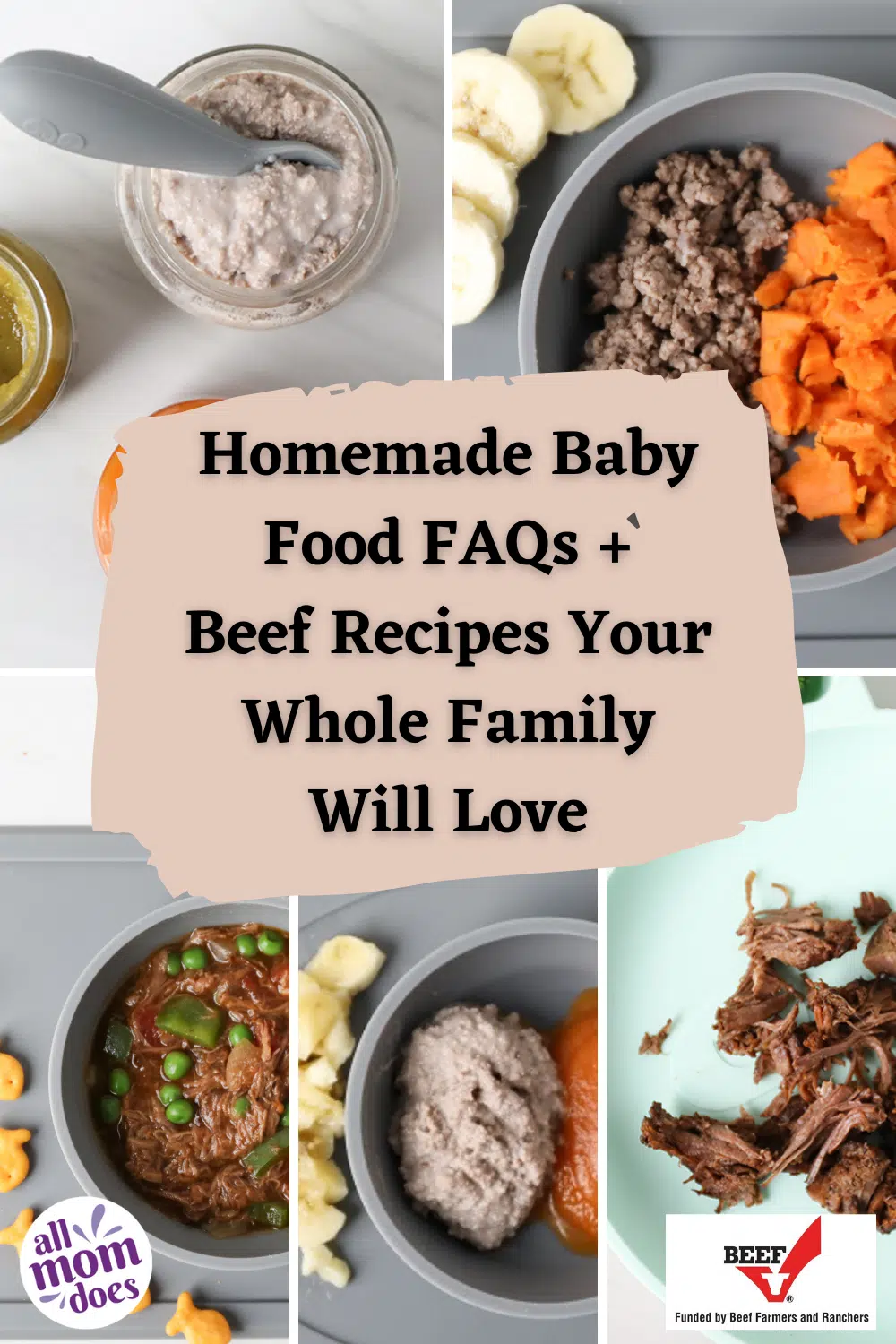You want to give your baby the best, so you’re curious about making your own baby food but you probably have some questions. There’s a lot of information about making fruit- or veggie-based purees, but what about proteins, like beef? Beef is a great first food for your baby, especially since prenatal iron stores are exhausted by six months and babies can’t get all they need from breastmilk alone. Beef provides this critical nutrient, along with zinc and choline which are critical for healthy brain development. In fact, the American Academy of Pediatrics, the Women Infants and Children’s Program (WIC), and the Dietary Guidelines for Americans all recommend introducing nutrient-dense solid foods – like beef – to infants and toddlers.
This post is sponsored by the Washington State Beef Commission.
Here’s your guide to making your own meat-based baby foods so you know your baby is getting top-notch nutrition from the very beginning.
1. What food should I feed my baby first? Should I introduce foods in a specific order?
There is no medical evidence that introducing foods in a certain order has any benefit. This takes the pressure off; you’re free to introduce foods in whatever order you like! When you begin feeding your baby solid foods, start with single-ingredient purees. This can include beef from very early on. As your baby demonstrates that their digestive system can tolerate these foods, you can move on to multi-ingredient foods.
2. Can my baby eat meat if they don’t have teeth yet?
Teeth aren’t necessary to eat solid foods! First molars don’t come in until your baby is a year or more – and they may be as old as three before they have all their molars. Until that happens, babies chew and grind their food with their gums – and feeding beef and other meats to your baby is appropriate and beneficial. What’s most important is that the texture is appropriate for your baby’s feeding stage, and that the meat you serve is soft and tender so your baby can mash it with their gums.
3. Is it safe to make my own baby food with meat?
Yes! Just make sure to keep food safety in mind. Wash your hands before cooking, wash all produce thoroughly, store raw meat and cooked foods safely, avoid cross-contamination when cooking, and cook all meats to the recommended minimum internal temperature. These temperatures are:
- Fresh beef (steaks or roasts): 145 degrees Fahrenheit
- Ground beef: 160 degrees Fahrenheit
- Poultry: 165 degrees Fahrenheit
Store all cooked baby food in your refrigerator for no more than 1-2 days. If your baby won’t consume it within that time, freeze it. Homemade baby food can be frozen for 3-4 months.
4. Is making meat-based baby food hard? How can I make baby food easily?
Baby food is really easy – especially when you feed your baby foods you were already cooking for the rest of your family! There’s no need to make separate meals. You probably already have the tools you need in your kitchen, including:
- Food processor, mini-chopper, or blender: Puree food to the appropriate texture for your baby; add water, formula, or breastmilk to thin it if needed.
- Potato ricer: Great for mashing vegetables into a finer texture.
- Ice cube tray: Babies don’t eat much at once; save time by making large volumes of baby purees, freeze them in an ice cube tray, then pop them out and keep them in a Ziploc freezer bag for easily accessible single servings.
- Slow cooker or Instant Pot: These are great for cooking beef roasts and other foods to a soft texture that’s perfect for your baby. You can even use them for foods like squash!
5. My baby leaves a lot of food on the tray. How do I know they’re getting enough?
For babies, eating is a multi-sensory experience. Yes, it serves a purpose to get nutrition in their little bellies – however it’s also fine motor skills practice, a time to learn about and experience new flavors and textures, and a social bonding experience when they’re sitting around the dinner table with the rest of the family. So while nutrition is an important thing, it’s not the only thing.
That being said, because the amount of food that makes it into your baby’s tummy is pretty small, it’s important to make every bite count. Nutritionally dense foods like beef deliver vital protein, iron, and other nutrients to your baby and have a pretty big bang-for-your-bite so it’s a great option during meal times.
Finally, babies naturally regulate their appetite so it’s rare that a baby doesn’t get enough to eat. Up until they’re a year old solid foods are complementary and if your baby is hungry, they’ll naturally take the extra calories they need through bottle or breast.
6. What are some baby food recipes with beef?
Almost any recipe you make with beef can be adapted and served to your baby. Here are some serving ideas, along with a few recipes your whole family can enjoy together – including your littlest member!
- Tacos: Is it Taco Tuesday in your house? This homemade taco recipe has way less salt than those seasoning packets, making it a great option for littles. Feed them all the components of tacos on their tray for them to get the full flavor experience. If you’re feeding a younger baby grind the beef using a chopper or food grinder to make it the appropriate texture. If you’re feeding a new-to-solids baby, this is a great starting point to introduce beef. Simply reserve some of your fully cooked ground beef before adding the seasoning. Puree the beef in a food processor, blender or grinder, adding liquid such as breastmilk, formula or water as needed to loosen the texture or consistency.
- Meatballs: Meatballs are soft, tender, and need very little modification for your self-feeder. Make your favorite meatball recipe and either cut up or crumb up meatballs into small bite-sized pieces, or shape a few into a log shape before cooking so your baby can easily hold the whole thing in their hand and nibble on the end.
- Moroccan Beef and Sweet Potato Stew: Beef from the slow-cooker or pressure-cooker is tender and easily shredded. Your early eater will love this dish, and so will the rest of your family. This multi-ingredient meal is ideal for a baby who has some experience with solid foods and for a family who loves exciting flavors. Simply break down the meal into baby-sized pieces and ingredients on their plate so they can explore all the textures and flavors.
- Pasta with Meat Sauce: Pasta is always a hit. Boost the nutritional value of this meal by adding sauce with ground beef; this recipe for homemade sauce has much less sodium than the packaged versions at the grocery store.
- French Dip: The adults in your family will love this, the kids will gobble it up, and the baby will enjoy the flavors right along with you. Follow this recipe. To make it in your slow cooker, brown all sides of a 3-pound chuck roast on high in oil, then saute one sliced onion and 3 minced cloves of garlic on medium. Transfer everything to a slow cooker, pour in 2 cans (4 cups) low-sodium beef broth and cook on high for 4 hours or low for 6 hours until the meat is tender. Strain the broth and season with Worcestershire, salt & pepper to taste for au jus. Serve the roast on toasted buns and dip in au jus. Serve the shredded beef (without the au jus) to your early eater.
If you have questions about starting solid foods, always consult your physician or health care provider first.
PIN THIS!

RELATED:
https://www.allmomdoes.com/2021/02/17/what-can-my-baby-eat-as-they-begin-eating-solid-foods/
https://www.allmomdoes.com/2021/03/08/how-can-i-safely-feed-my-baby-beef/

















